|
 Hydropus ardesiacus Hydropus ardesiacus
SynonymsLeucopaxillus ardesiacus
Pleurella ardesiaca
BiostatusPresent in region - Indigenous. Endemic
Images (click to enlarge)
Caption: Fig. 35 | 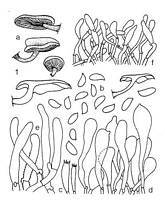
Caption: Pleurella ardesiaca (Stev. and Taylor) Hk.: a. carpophores (nat. size). b. spores (2000 x). c basidia
(1000 x). d cheilocystidia (1000 x). c. caulocystidia (1000 x). f. cuticle (500
x) | 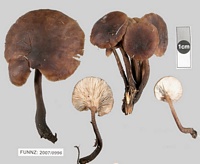
Owner: J.A. Cooper | 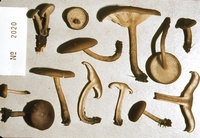
Caption: ZT2020
Owner: E. Horak: © Creative Commons Attribution-Noncommercial 3.0 New Zealand | 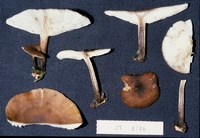
Caption: ZT8746
Owner: E. Horak: © Creative Commons Attribution-Noncommercial 3.0 New Zealand | 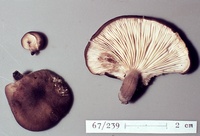
Caption: ZT67-239
Owner: E. Horak: © Creative Commons Attribution-Noncommercial 3.0 New Zealand | 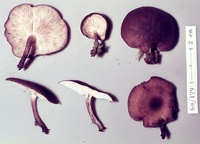
Caption: ZT68-179
Owner: E. Horak: © Creative Commons Attribution-Noncommercial 3.0 New Zealand |
Article: Stevenson, G. (1964). The Agaricales of New Zealand: V. Kew Bulletin 19(1): 1-59.
Description: Pileus 2-3 cm diam., dark grey, convex with strongly down-rolled margin, silky fibrillose; flesh white, solid, with a water soaked layer above the gills. Gills adnexed, pale grey, long and short intercalating, some forking. Stipe 2.5 x 0.5-0.7 cm, solid, fleshy, pale grey fawn with darker grey markings, base surrounded by grey hyphae. Spores 5-6 x 2-5-3 µm, strongly amyloid (Fig. 35); print white.
Habitat: On fallen log in Nothofagus forest, Butterfly, Wellington, 8.4.1961, G. M. Taylor (type).
Article: Horak, E. (1971). A contribution towards the revision of the Agaricales (Fungi) from New Zealand. New Zealand Journal of Botany 9(3): 403-462 (http://www.rsnz.org/publish/abstracts.php).
Notes: A thorough study of the type and several collections made by ourselves clearly
showed that this species is taxonomically unrelated to Leucopaxillus. Details of
its systematic position will be published in a later paper.
Article: Horak, E. (1971). Contributions to the knowledge of the Agaricales s.l. (Fungi) of New Zealand. New Zealand Journal of Botany 9(3): 463-493 (http://www.rsnz.org/publish/abstracts.php).
Description: Pileus 10-35 mm diam., convex later becomes
flat or depressed. margin involute; dark grey or smoky dark brown; densely covered
with minute squamules, sometimes pruinate, dry, neither hygrophanous nor striate.
Lamellae adnate, emarginate or subdecurrent, crowded, when young white, later
turning cream, brown coloured in old specimens or after bruising; gill edge
fimbriate or floccose, con colorous. Stipe 5-30 x 2-7 mm. excentric or lateral,
rarely centrally inserted, cylindrical. curved, solid; concolorous with pileus
or paler, dotted with darker dots (caulocystidia) near the apex, fibrillose
or squamulose towards the base, dry, veil remnants absent. Context white, below
the cuticle and in the cortex of the stipe dark brown. Smell acidulous. Taste
mild.
Spore print white. Spores 4.5-6(6.5) x 2-3
µm, elliptical or subcylindrical, sometimes curved and slightly comma-like,
smooth, thin-walled, strongly amyloid, germ pore absent. Basidia 18-20 x 3.5-5
µm. Cheilocystidia 20-60 x 7-18 µm., clavate or cylindrical, occasionally with
a short projection at the apex, hyaline, thin-walled, forming a sterile zone
at the edge. Caulocystidia 30-65 x 6-7 µm, cylindrical, thin-walled, with brown
membranal or epicellular pigment. Cuticle a palisade composed of erect or intermixed
clavate or cylindrical cells (15-50 x 5-10 p.), membrane thick-walled, not gelatinised,
strongly encrusted with brown pigment, clamp connections present.
Habitat: On rotten wood and bark (infrequently on
living trees) of Phyllocladus alpinus, rarely on Dacrydium cupressinum
or Nothofagus spp. New Zealand.
Notes: Macroscopically the monotypic genus Pleurella
resembles Melanoleuca Patouillard 1897 and to a lesser degree Leucopaxillus
Boursier 1925. The existence of several distinct characters however, places
Pleurella in an independent position between the two above-mentioned
genera. The main differences separating Pleurella from Melanoleuca
or Leucopaxillus are: smooth, strongly amyloid, elliptical or subcylindrical
spores, conspicuous cheilocystidia, form of the carpophores and habitat.
This fungus normally grows on rotten wood
of Phyllocladus alpinus (Podocarpaceae) but also occurs rarely on Dacrydium
cupressinum (Podocarpaceae) or Nothofagus (Fagaceae). The species
was observed many times in the wet lowland forests of the West Coast of the
South Island, between Reefton and Haast.
|